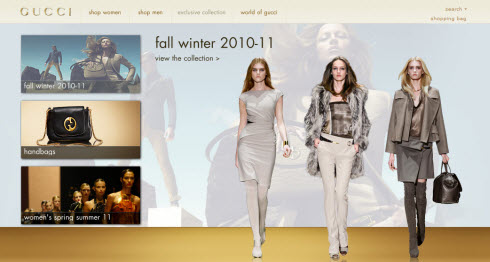How To: Build a Digital Flagship
In the constantly evolving online world where buzz words run rampant, the term “Digital flagship†has emerged, mainly due to recent launches by some of the most globally recognized fashion houses. At Fashion’s Collective, we see this as a welcomed advance from the various brand websites and microsites that have preceded.
The future of the web is all about connectivity and providing a fluid user experience where one can seamlessly navigate through related content with the ability to share, save, purchase, obtain, store information, etc. all on the same interface.

A screenshot of the recently revamped Gucci website, with more digital flagship characteristics
For brands, rather than establish microsites for campaigns, like we would physical pop-up shop locations, creating a digital flagship allows the website to be the main hub for all brand communications. Not only does this streamline management on the business-side, but it better serves the customer by presenting all brand content in one central place.
Previously, we covered the 7 Tenets of Successful Brand Websites, in today’s post we’re getting a bit more granular. How, exactly, do you go about creating a digital flagship? The answer is that this is a detailed process that should be carefully mapped out, managed and executed to ensure the best experience for the brand and for the end-user. For internal project owners, the main points of consideration below can be used as a guide:
1. Audience Engagement: Understanding how your target audience currently finds and interacts with your brand online is a necessary part of the process. Knowing what people search for, where they are coming from and what their behaviors indicate once on a branded portal has strong implications for all other components; content, social, design and technology. This doesn’t only involve a deep dive into the existing site (and microsite) analytics, but also to other third party sites and platforms where your audience lives.
2. Content: Having compelling content that is refreshed on an ongoing basis provides value and keeps people coming back to the site. In the past, brand communications may have been refreshed only seasonally, however with the advent of social media and mobile accessibility, there is an immediacy that has become expected. For brands, it is not always realistic to churn out new content on a rolling basis, but there are opportunities to keep things updated through social media.
–Content Audit: Conduct a thorough review of the existing content the brand has access to. Be creative, think of places content may already exist that has been, so far, under-utilized. And then ask, what new content would make this site more compelling? What is my target audience most interested in?
–Content Map: Now that you have a handle on the content to present, map out how it will be presented. This should align with the Sitemap and Information Architecture. Think about creating a fluid user experience that combines different types of content (brand story, product-related, social) in a way that feels natural to the user.
–Management resources/tools for updates: Based on the content plan, how often are updates required? Is there a team to manage this? If so, what are their technical capabilities? Chances are, you’ll need a Content Management System that is user-friendly. Knowing this early on helps ensure the technical platforms chosen are the right ones to help manage the site going forward.
3. Technology: Explore, review, research and learn about the future of technology. In what direction are various platforms headed? How should your site be optimized to handle this from the start? Scalability is key and you’ll want your site to evolve with advances in technology. For example, you wouldn’t want to build an all-Flash site because it wouldn’t work on an iPad or mobile device. Plus, with the new programming language of HTML5 and JavaScript, you can create an experiential , exciting aesthetic that is SEO-friendly and requires less bandwidth compared to Flash. The technical phase is a good time to have third party consultant with internal IT teams to ensure the final decision is based on the greatest understanding of technology possible. This is one of the most important aspects to the project because the technology is often the most costly component and can also be the most limiting to design and social if the wrong platform is chosen.
4. Design: The design direction of the site is the first thing people notice. As a luxury or fashion brand, it’s important that the design convey the same level of polish, prestige and craftsmanship as all other brand materials (from print ads to the products themselves). The design should be more than a simple translation of print collateral; rather, the design should feel as though it was intended to live online. Interaction is the critical element here, through interesting navigation, zoom tools, etc. the visuals sell the product, the brand and the lifestyle. In terms of management, think of how new visual assets will be created, uploaded and shared by users to facilitate easy management and support sharing.
5. Social: It is only natural that our interactions with brands online have social components, especially given the high degree of influence social media now has on people’s perceptions and purchase decisions. For the brand, it’s all about tapping into the social networks most appropriate for the audience and finding a comfort level in such a transparent digital world. For a digital flagship, social elements need to be incorporated to encourage sharing, exploring and a sense of conversing with the brand. Going forward, it will be increasingly important to allow users to engage in social actions with a larger community while staying within a branded environment (think Facebook open graph and Facebook connect).
How To: Build a Digital Flagship originally appeared on Fashion’s Collective, and is republished on Signature9 with permission.

